Cantaloupe is a juicy, sweet fruit that’s a favorite among humans—but what about reptiles? Many bearded dragon owners find themselves asking, can bearded dragons eat cantaloupe? While it might seem like a healthy treat, not all fruits are safe for reptiles, and making the wrong dietary choice could affect your pet’s health.
So, can bearded dragons eat cantaloupe safely, and if so, how much is too much? In this complete feeding guide, we’ll explore the nutritional value of cantaloupe, the risks and benefits of offering it to your bearded dragon, and how to serve it properly to keep your reptile happy and healthy.
Can Bearded Dragons Eat Cantaloupe Safely?
Cantaloupe might look like a refreshing treat, but is it truly safe for your bearded dragon? In this section, we’ll explore whether bearded dragons can eat cantaloupe safely, how much is appropriate, and what age-specific considerations you should keep in mind.
Why Bearded Dragons Like the Taste and Texture of Cantaloupe
Bearded dragons are naturally drawn to colorful and sweet-smelling fruits, and cantaloupe checks both boxes. Its bright orange flesh stands out visually, making it easy for beardies to recognize. The fruit also has a sweet aroma and juicy texture, which can stimulate your dragon’s interest and appetite. Many bearded dragons enjoy the moisture content, especially in warmer weather, as it helps with hydration.
In the wild, bearded dragons are opportunistic feeders. They tend to explore and try various plant-based foods. Cantaloupe’s soft consistency also makes it easy to chew and digest. However, just because it’s appealing doesn’t mean it’s ideal as a regular part of their diet. Like many fruits, cantaloupe should be seen as an occasional treat rather than a staple food.
Is Cantaloupe Safe or Harmful for Bearded Dragons to Eat?
Cantaloupe is not toxic to bearded dragons, which makes it safe when served correctly and in moderation. It doesn’t contain any harmful compounds or chemicals known to be dangerous for reptiles. However, it has a few nutritional imbalances that should not be overlooked.
The biggest concern is its calcium-to-phosphorus ratio, which is poor. Too much phosphorus can interfere with calcium absorption and may lead to health issues like metabolic bone disease (MBD). Cantaloupe is also high in natural sugars. While not directly toxic, excess sugar can cause digestive upset or obesity if fed too often.
So while cantaloupe is technically safe, it must be offered responsibly. Always remove the rind and seeds before serving, and cut the fruit into small, manageable pieces.
How Much Cantaloupe Can Bearded Dragons Eat Without Risk?
When it comes to cantaloupe, moderation is key. Bearded dragons should only eat a small amount at a time—about a teaspoon’s worth for an adult dragon. This portion can be offered once a week, or less frequently depending on the rest of their diet.
Feeding too much cantaloupe can lead to issues over time. The fruit’s sugar content may contribute to weight gain and digestive problems. More importantly, its poor calcium-to-phosphorus ratio can interfere with calcium absorption. This puts your bearded dragon at risk for metabolic bone disease, especially if calcium-rich foods aren’t included alongside.
To stay safe, always balance cantaloupe with leafy greens high in calcium, such as collard greens or dandelion leaves. Never let fruit become more than 10% of your beardie’s overall diet.
Can Baby Bearded Dragons Eat Cantaloupe Too?
Baby bearded dragons have more delicate digestive systems and higher calcium needs than adults. While cantaloupe is not toxic, it’s not the best choice for young dragons. The fruit’s high sugar content and poor calcium-to-phosphorus ratio can disrupt proper bone development in growing beardies.
If you choose to offer cantaloupe to a baby bearded dragon, it should be in very small amounts and only on rare occasions. A sliver once every few weeks is more than enough. Prioritize high-protein foods like insects and calcium-rich greens to support healthy growth.
It’s also worth noting that baby dragons may be more prone to dehydration or diarrhea from sugary fruits. Monitor their stool and energy levels closely if you introduce new foods. When in doubt, stick to staple foods until they’re older and their systems are more resilient.
Nutritional Value of Cantaloupe for Bearded Dragons
Cantaloupe may seem like a healthy fruit, but how does it actually measure up for bearded dragons? In this section, we’ll break down the key nutrients in cantaloupe and explain how they affect your reptile’s health and diet.
Cantaloupe’s Vitamin and Mineral Profile (per 100g)
Cantaloupe is rich in vitamins and minerals that are essential for both humans and reptiles. In every 100g serving, it contains about 34 calories and over 90g of water. It also provides small amounts of protein (0.84g) and fat (0.19g), making it a low-calorie fruit.
When it comes to micronutrients, cantaloupe offers a strong boost of vitamin A, with approximately 3,382 IU per 100g. It also contains vitamin C (36.7mg), which can help support immune function in reptiles. In addition, it includes trace amounts of minerals like calcium (9mg), phosphorus (15mg), and potassium.
While these numbers sound promising, the balance of nutrients is just as important as the presence of them. Cantaloupe may offer some health benefits, but not all nutrients are in the ideal ratios for a bearded dragon’s long-term diet. It’s best used as a supplement to more nutritionally balanced foods.
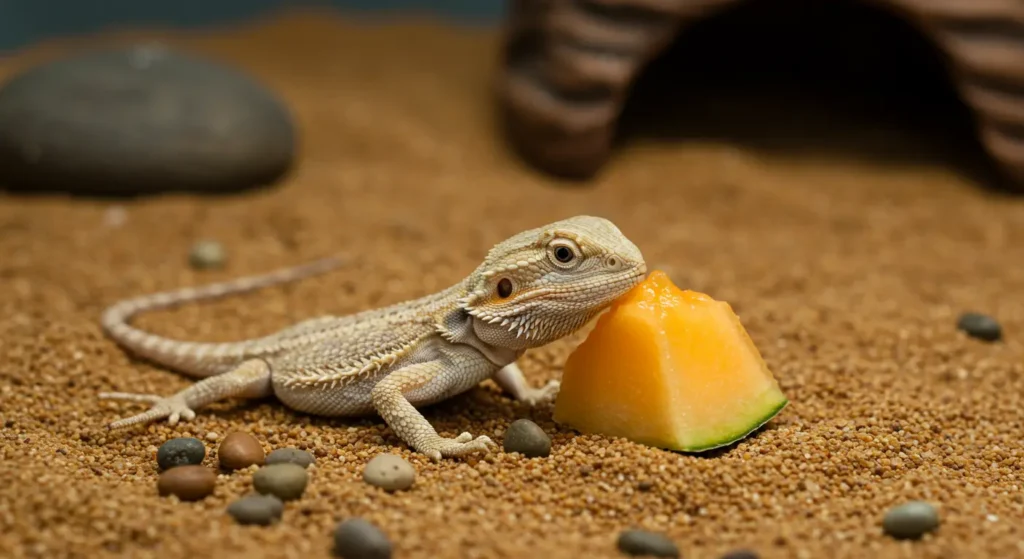
Calcium to Phosphorus Ratio Explained
The calcium to phosphorus ratio in cantaloupe is one of the key reasons it should be fed in moderation. Bearded dragons need a diet that contains more calcium than phosphorus—ideally, a ratio of 2:1. However, cantaloupe contains approximately 9mg of calcium and 15mg of phosphorus per 100g. That puts its ratio at around 0.6:1, which is considered poor.
Why does this matter? Phosphorus binds to calcium in the digestive system, preventing it from being absorbed. Over time, this imbalance can lead to a serious condition called metabolic bone disease (MBD). If you’re feeding cantaloupe, it’s crucial to pair it with high-calcium foods like collard greens or dandelion leaves to help offset this issue.
Cantaloupe can be part of a healthy diet—but only when served alongside other foods that restore the right mineral balance.
Oxalates, Sugars, and Hydration Content
Cantaloupe has low oxalate levels, which makes it safer than other fruits that may interfere with calcium absorption. Oxalates are compounds found in plants that bind with calcium and reduce how much of it the body can use. In cantaloupe, oxalate levels are low, so they aren’t a major concern.
However, sugar content is much higher. Cantaloupe contains nearly 8g of natural sugars per 100g. This amount may not seem excessive, but for small reptiles like bearded dragons, even natural sugars can disrupt digestion or lead to weight gain if consumed too frequently.
On the positive side, cantaloupe is over 90% water. This makes it a great option for boosting hydration, especially during hot weather or if your beardie isn’t drinking enough. Just remember: too much water-rich fruit can cause loose stools. Always balance cantaloupe with drier, fibrous vegetables to maintain proper digestion.
Is Cantaloupe a Good Source of Calcium for Beardies?
Cantaloupe is not a reliable source of calcium for bearded dragons. With only about 9mg of calcium per 100g, it falls far short of the amount needed to support bone strength and overall health. Bearded dragons need calcium daily, especially during growth stages or for females during egg-laying periods.
Because cantaloupe also has more phosphorus than calcium, it not only fails to provide enough calcium—it may actually prevent your dragon from absorbing the calcium from other foods. This imbalance can be dangerous if fruits like cantaloupe are offered too often.
To make cantaloupe safer, serve it with high-calcium greens or dust the meal with a reptile-safe calcium supplement. Use cantaloupe as a treat, not a staple, and always make sure the rest of your beardie’s diet is rich in calcium to support strong bones and a healthy metabolism.
How to Feed Cantaloupe to Bearded Dragons the Right Way
Feeding cantaloupe to your bearded dragon might seem simple, but doing it the right way is essential for their health. In this section, you’ll learn how to properly prepare, portion, and serve cantaloupe to ensure it’s a safe and enjoyable treat for your beardie.
Preparing Cantaloupe: What to Remove and Why
Proper preparation is key when offering cantaloupe to your bearded dragon. Start by thoroughly washing the outer rind of the cantaloupe to remove any pesticides, dirt, or bacteria. Although your dragon won’t eat the skin, a clean surface ensures no contaminants are transferred when cutting.
Next, slice the cantaloupe in half and scoop out all the seeds. Cantaloupe seeds are a choking hazard and should never be fed to reptiles. They also offer no nutritional value. After removing the seeds, discard the rind as well. Bearded dragons cannot digest the tough outer skin, and it could cause impaction or intestinal blockage.
Once cleaned and deseeded, cut the fruit into small, bite-sized pieces. Each piece should be no larger than the space between your dragon’s eyes. This size guideline helps prevent choking and makes it easier for them to chew and swallow safely. Always serve cantaloupe fresh and at room temperature for the best digestion.
Portion Size: Slicing and Serving Guidelines
Portion size is one of the most important factors when feeding cantaloupe to your bearded dragon. Because of its sugar content and poor calcium-to-phosphorus ratio, cantaloupe should be served sparingly. A good portion for an adult bearded dragon is about one to two small cubes—roughly the size of a teaspoon.
Cut the cantaloupe into small, manageable cubes. Avoid slicing them too thin or too thick. The pieces should be soft, easy to chew, and not slippery or stringy. Use the eye-width rule: if the piece is wider than the space between your dragon’s eyes, it’s too big.
Offer cantaloupe as part of a mixed salad alongside calcium-rich greens like mustard greens or collard greens. This pairing helps offset the fruit’s nutritional imbalances. Also, avoid serving it alongside other sugary fruits on the same day to prevent digestive upset. Always remove any uneaten fruit within a few hours to avoid spoilage.
Fresh vs. Frozen Cantaloupe: What’s Best?
Fresh cantaloupe is always the better choice for bearded dragons. It retains more natural nutrients and doesn’t contain any added sugars or preservatives. Fresh fruit is also easier to portion, has better texture, and is free of additives that could irritate a reptile’s digestive system.
Frozen cantaloupe may seem convenient, but it often loses nutritional value during freezing. More importantly, many frozen fruits sold in stores come pre-sweetened or treated with preservatives, which can be harmful to reptiles. Even if you freeze it yourself, once thawed, the fruit can become overly soft and watery—making it harder for your beardie to eat.
If frozen cantaloupe is your only option, make sure it’s plain, unsweetened, and thoroughly thawed. Let it return to room temperature before serving. Never serve it cold, as chilled foods can shock your dragon’s digestive system. Still, fresh fruit should always be your first choice when available.
Feeding Frequency: Once a Week or Less?
Bearded dragons should only eat cantaloupe occasionally. Once a week is the maximum recommended frequency for healthy adults. In some cases, once every two weeks may be even safer—especially if your beardie’s diet already includes other fruits.
The reason for this limit is due to cantaloupe’s nutritional profile. While it offers hydration and vitamins, it lacks the calcium bearded dragons need and contains too much sugar. Feeding it too often can disrupt mineral balance and contribute to metabolic bone disease or obesity.
Younger dragons and those with health conditions should eat fruit even less frequently. Their diets should focus more on calcium-rich greens and insects. If you notice any changes in stool consistency or appetite after feeding cantaloupe, pause and consult a reptile vet. Moderation is the key to making this treat safe and beneficial.
Common Risks and Health Concerns When Feeding Fruit
Fruits like cantaloupe can be a tasty treat for bearded dragons, but they also come with potential risks. In this section, we’ll explore common health concerns linked to overfeeding fruit, so you can make informed, safe choices for your pet.
Calcium Deficiency and Metabolic Bone Disease (MBD)
Calcium deficiency is one of the most serious health risks for bearded dragons. Without enough calcium in their diet, they may develop Metabolic Bone Disease (MBD). This condition weakens the bones, causes deformities, and leads to pain and mobility issues. It is common in reptiles that eat too many phosphorus-rich foods and not enough calcium.
Cantaloupe contains more phosphorus than calcium, which can throw off the mineral balance. Phosphorus binds to calcium in the digestive tract, making it harder for the body to absorb what it needs. Over time, this imbalance can have long-term effects.
Feeding cantaloupe too often, especially without calcium-rich foods, increases the risk of MBD. Signs include twitching, soft jawbones, or a curved spine. Once symptoms appear, treatment becomes more difficult. That’s why prevention is critical. Always support your beardie’s calcium needs with proper diet and supplements when necessary. Keep sugary fruits like cantaloupe as occasional treats only.
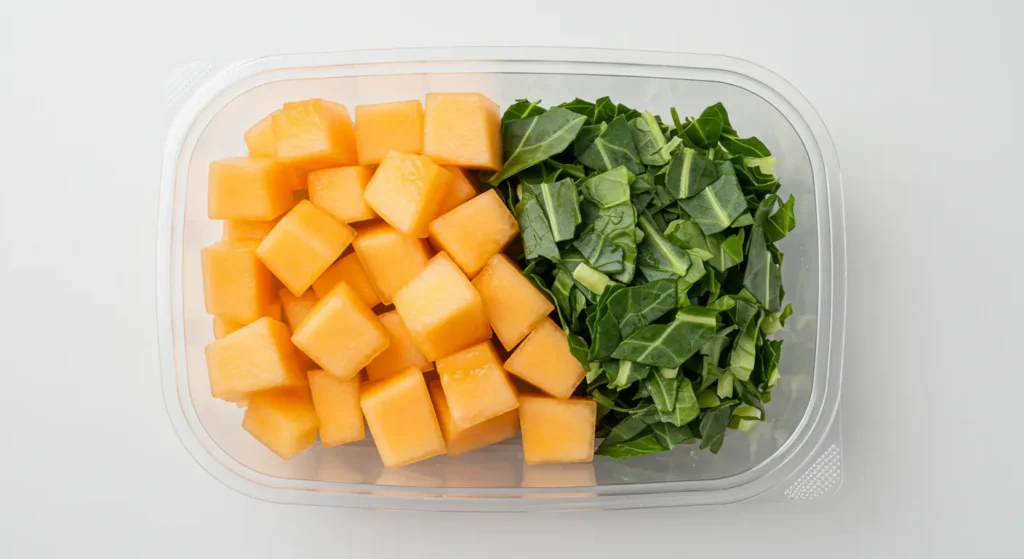
Sugar Overload and Digestive Sensitivity
Bearded dragons are not designed to handle large amounts of sugar. Cantaloupe contains about 8g of sugar per 100g, which can be a lot for a small reptile. While it may taste great to your pet, too much sugar can lead to digestive upset.
Signs of sugar overload include diarrhea, bloating, and a lack of appetite. These symptoms usually appear within a few hours after eating too much fruit. If left unaddressed, long-term high sugar intake can lead to obesity and even fatty liver disease in reptiles.
Juvenile dragons are especially vulnerable because their digestive systems are still developing. Even a small slice of cantaloupe can overwhelm their gut bacteria. That’s why fruit should never be a daily part of your beardie’s diet. Stick to feeding cantaloupe occasionally, and always monitor your dragon afterward for any unusual behavior or stool changes.
Poor Ca:P Ratio – Why It Matters Long-Term
Maintaining a proper calcium-to-phosphorus (Ca:P) ratio is essential for a bearded dragon’s bone health and overall well-being. Ideally, foods should offer a ratio close to 2:1—meaning twice as much calcium as phosphorus. This balance supports efficient calcium absorption and helps prevent skeletal issues.
Unfortunately, cantaloupe has a poor Ca:P ratio of approximately 0.6:1. In this case, phosphorus outweighs calcium, which poses a problem. During digestion, phosphorus binds to calcium, reducing its absorption in the body. Over time, this imbalance can deplete calcium stores, weakening the bones and leading to metabolic bone disease (MBD). MBD is a painful and potentially life-threatening condition in reptiles that results in brittle bones, deformities, and mobility issues.
Even with calcium supplementation, a diet high in phosphorus can interfere with calcium uptake. That’s why it’s important to feed cantaloupe only occasionally and always alongside calcium-rich vegetables like collard greens or dandelion greens. By managing the Ca:P ratio carefully, you help protect your bearded dragon from long-term health complications.
Combining Cantaloupe With High-Calcium Greens
One way to make cantaloupe safer for bearded dragons is to combine it with high-calcium vegetables. This helps balance the fruit’s poor calcium-to-phosphorus ratio. Leafy greens like collard greens, mustard greens, arugula, and dandelion leaves are great choices.
When you serve cantaloupe, add a generous portion of these calcium-rich greens. This combination allows the meal to offer hydration and sweetness without compromising bone health. It also boosts the nutritional value of your beardie’s salad bowl.
Another helpful tip is to lightly dust the cantaloupe and greens with a calcium supplement. Choose a reptile-safe powder, preferably one that includes vitamin D3 if your dragon doesn’t get much UVB light. Avoid pairing cantaloupe with other fruits in the same meal, as that can create a sugar-heavy mix with little nutritional balance.
By pairing cantaloupe with the right greens, you can give your beardie a treat that’s both enjoyable and supportive of their long-term health.
What Fruits Can Bearded Dragons Eat Besides Cantaloupe?
Bearded dragons enjoy a variety of fruits, but not all are equally safe or nutritious. In this section, we’ll explore healthy alternatives to cantaloupe and how to rotate fruits wisely in your beardie’s diet.
Best Fruits for Beardies: A Quick List
Bearded dragons can safely enjoy a variety of fruits in moderation. Some of the best options include blueberries, papaya, figs, mango, and strawberries. These fruits are lower in oxalates and have a better calcium-to-phosphorus ratio than many others.
Apples (peeled), pears, and seedless grapes can also be offered occasionally. Just like with cantaloupe, all fruits should be cut into small, bite-sized pieces. Make sure they’re free of seeds, pits, and skins that could be difficult to digest.
It’s important to use fruits as treats, not as a daily food source. Fruit should make up no more than 10% of your bearded dragon’s total diet. Focus on nutrient-rich vegetables and insects first. Fruits are great for hydration and variety, but they should always support—not replace—your beardie’s core nutritional needs.
Cantaloupe vs. Watermelon, Honeydew & Berries
Cantaloupe is sweet and hydrating, but how does it compare to other popular fruits? Watermelon is similar in water content but lower in nutrients overall. It’s very sugary and has little calcium, so it should also be limited.
Honeydew is another melon that’s often offered, but it shares many of the same drawbacks as cantaloupe. Both are hydrating but lack the minerals bearded dragons need most. On the other hand, berries like blueberries, raspberries, and blackberries offer more antioxidants and fiber. They also tend to have a better calcium-phosphorus balance.
While no fruit is perfect, some offer more benefits than others. Berries are a better choice for weekly treats. Melons should be used sparingly. Always check calcium and sugar levels before offering any new fruit.
How to Rotate Fruits for a Balanced Diet
Rotating fruits is a smart way to give your bearded dragon variety without overloading on sugar or unbalanced nutrients. Instead of feeding the same fruit each week, switch between two or three options. This keeps your beardie’s meals interesting and lowers the risk of dietary imbalances.
For example, one week you can offer a few bites of cantaloupe. The next, try a small portion of strawberries or blueberries. In the third week, serve a sliver of mango or papaya. Always return to calcium-rich vegetables as the base of each meal.
Keeping a food diary can help you track what fruits are fed and how often. This prevents overfeeding and helps you spot patterns in your dragon’s digestion or appetite. Rotation adds variety without compromising long-term health.
When to Avoid Fruit Altogether
There are times when fruits, even in small amounts, should be avoided. If your bearded dragon is recovering from illness or has diarrhea, skip fruits entirely. High sugar and water content can worsen digestive issues.
Young dragons, especially under six months old, should eat mostly insects and greens. Their growing bodies need protein and calcium—not sugar. Fruit should be introduced cautiously and only on rare occasions.
Obese bearded dragons or those showing signs of metabolic bone disease (MBD) should also avoid fruit until their condition improves. In these cases, it’s best to consult a reptile vet for dietary guidance.
Fruits are a fun and healthy treat—but they’re not essential. There are times when skipping fruit altogether is the safest option for your beardie’s well-being.
In some cases, it may be safer to skip fruit entirely for a few days or more. If you’re unsure how long your bearded dragon can safely go without food, this guide explains everything you need to know.
Conclusion
If you’ve ever wondered can bearded dragons eat cantaloupe, the answer is yes—but only in moderation and with proper preparation. Cantaloupe offers hydration and some nutritional benefits, but its high sugar content and poor calcium-to-phosphorus ratio mean it should only be fed occasionally, not as a staple part of your dragon’s diet.
To safely include cantaloupe in your bearded dragon’s meal plan, always serve it in small, seedless, rind-free pieces, and pair it with high-calcium greens. Rotating cantaloupe with other safe fruits helps prevent dietary imbalances while keeping your pet’s diet interesting.
By understanding when and how bearded dragons can eat cantaloupe, you’ll make smarter feeding choices that support their long-term health and well-being.


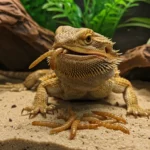

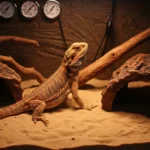

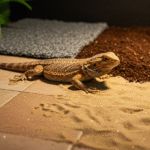
1 thought on “Can Bearded Dragons Eat Cantaloupe? A Complete Feeding Guide”